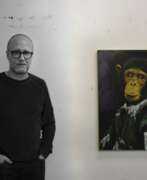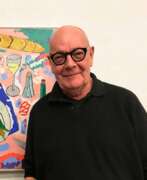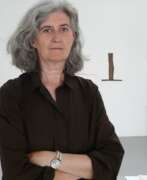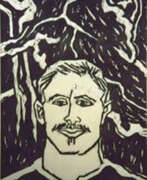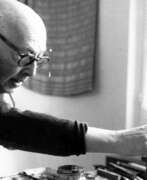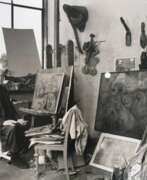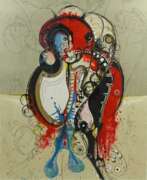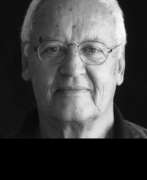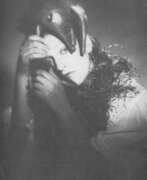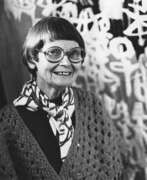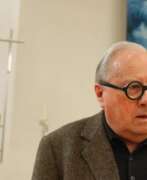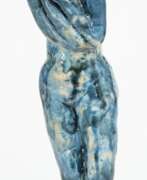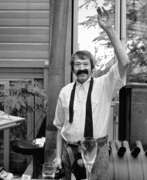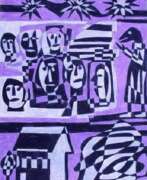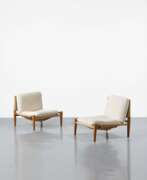Switzerland Contemporary art


Urs Aeschbach is a Swiss media artist working in various techniques. Nature is always a pictorial theme in Urs Aeschbach's paintings. Her main characters are mushrooms, woody plants, animals, jellyfish, as well as dogs and horses. The artist's paintings are inspired by photographs and illustrations. In addition to paintings, Eschbach creates art and construction projects, video works, as well as constructions and installations.


John Armleder is a Swiss performance artist, painter, sculptor, critic, and curator. His work is based on his involvement with Fluxus in the 1960s and 1970s, when he created performance art pieces, installations and collective art activities that were strongly influenced by John Cage. However, Armleder's position throughout his career has been to avoid associating his artistic practice with any type of manifesto.


Karl Otto Bachmann, a Swiss painter, graphic artist, and illustrator, began his artistic career in Luzern before moving to Zurich and pursuing freelance work. He achieved a breakthrough in 1943 with the publication of his "Faust" portfolio. Bachmann drew inspiration from his travels across Europe, often joining circus troupes for income and creative ideas. His paintings were characterized by imaginative and virtual settings, with themes revolving around the stage, carnival, and circus. Bachmann's elegant lines, delicate colors, and harmonious compositions made him a respected book illustrator. He actively participated in numerous exhibitions throughout his life, both domestically and internationally.


Stefan Berger-Teichmann is a contemporary Swiss painter who specializes in abstract art. He has exhibited his works in various galleries and museums in Switzerland, Germany, and the United States.
Berger-Teichmann's paintings are characterized by their expressive use of color, texture, and form. He often employs a variety of techniques and mediums to create layered, multi-dimensional works that invite the viewer to engage with the art on both a visceral and intellectual level. His work is often inspired by natural landscapes, but he also draws on his own emotional experiences and personal memories to create abstract compositions that are both powerful and evocative.


Francis Bott war als deutscher Maler ein Vertreter der „Zweiten École de Paris“, also des französischen „Informel“. Sein künstlerisches Schaffen weist zwei scheinbar gegensätzliche Schwerpunkte auf: surreale, phantastische Gegenständlichkeit und tachistisch, geometrische Abstraktion. Sein Werk besteht aus Gemälden, Glasmalereien, Handzeichnungen, Aquarellen, Gouachen, Plastiken und Objekten; auch als Bühnenbildner hat er sich betätigt.


Daniele Buetti is a Swiss visual artist who works in several modes including installation and intervention. The media he works with includes photography, sculpture, drawing, sound, video and digital forms. He is professor at University of Fine Arts Munster where he has taught since 2004. He lives and works in Zurich, Switzerland and Münster, Germany.
His work has been described as "an expression of world-weariness and the individual’s precarious existential orientation." In the 1990s Buetti's work served as a visual critiques of the consumption of beauty. This work often appropriated images of models and high-fashion consumer products from magazines that were pierced with a ballpoint pen.


Alois Carigiet was a Swiss graphic designer, painter, and illustrator. He may be known best for six children's picture books set in the Alps, A Bell for Ursli and its sequels, written by Selina Chönz, and three that he wrote himself. In 1966 he received the inaugural Hans Christian Andersen Medal for children's illustrators.


Armen Eloyan is an Armenian-born painter who lives and works in Zurich. He is known for his large-scale, hooligan depictions of anthropomorphic animals and figures, absurdist narratives in dark, existential works. His creations are inspired by caricature and street art, as well as by European masters.


Pierrette Favarger was a Swiss artist, renowned for her unique approach to ceramics and sculpture. Born in 1924, Favarger's work is distinguished by her refusal to use fire for baking her creations. This unusual technique allowed her to incorporate materials like textiles, feathers, fur, and even nails into her clay work, which could not withstand high temperatures. Her style, focusing on terracotta and the human figure, stood apart from contemporary trends, defying modern labels.
Throughout her career, Favarger participated in significant collective exhibitions, such as the one in Faenza in 1984, Zürich's Heimatwerk in 1986, and China in 1987. Additionally, her works were showcased in numerous solo exhibitions, including those at the Musée d'art et d'histoire de Neuchâtel in 1975 and 1999, and the Galerie Ditesheim in 1982 and 1990. Her distinctive work was again exhibited in 2020 at the Musée Ariana in the "Anatomie fragmentée" exhibition alongside pieces by Jean-Marie Borgeaud, Paul March, and Patriciu Mateescu.
Pierrette Favarger's career, marked by her innovative approach to ceramics, made a significant impact in the art world. Her works, which often challenged conventional ceramic techniques, are a testament to her creative spirit and technical mastery.
If you are a collector, auctioneer, or an expert in art and antiques, and wish to stay updated on new product sales and auction events related to Pierrette Favarger, sign up for our updates. This subscription is exclusively for alerts on new sales and events, ensuring you stay informed about the latest in this field.


Michel Favre is a Swiss painter and sculptor living and working in Martigny.
Michel trained as a marble sculptor from a young age: learning to work with materials, honing his craft and technical skills, and practicing restoration. In 1972 he opened his atelier in Martigny and until 1980 he created almost exclusively stone sculptures, but since the 1990s he has incorporated bronze, glass and other materials into his work. Since 1996 he has also created video installations, combining plastic arts, film, photography and new media. Michel Favre travels extensively and is passionate about archaeology.
The main motif of the sculptor's works is the fragile human being in a looming world of machines and technology. In his three-dimensional images, people are most often tiny and ant-like, trying to change something in the huge world around them.
Michel Favre has been a member of VISARTE (Society of Swiss Artists, Sculptors, Architects) since 1983 and has been active in numerous exhibitions around the world.


Sylvie Fleury is a Swiss contemporary pop artist known for her installations, sculpture, and mixed media. Her work generally depicts objects with sentimental and aesthetic attachments in consumer culture, as well as the paradigm of the new age, with much of her work specifically addressing issues of gendered consumption and the fetishistic relationships to consumer objects and art history.


Tsugouharu Foujita was a French twentieth-century artist of Japanese descent. He is known for his unique style, combining elements of Japanese painting and printmaking with European realism.
Foujita created a wide range of works in a variety of genres, including nudes, images of cats, portraits of women and children, and self-portraits. He later converted to Catholicism and began creating paintings with religious themes. The artist was internationally recognized, and his work was exhibited in many countries around the world. His work was characterized by the perfection of pictorial technique, virtuosity of drawing and an atmosphere of sophistication. The master also showed talent in graphics, photography, ceramics, theater, cinema and fashion design. Prices for his paintings were comparable to those of Picasso's works.


Robert Lvovich Genin (Russian: Роберт Львович Генин) was a Jewish-born artist of the first half of the twentieth century who worked in several countries, including the Russian Empire, Germany, France, Germany, Switzerland, and the USSR. He is known as a painter and graphic artist.
Robert Genin worked in a variety of genres including landscapes, portraits, genre compositions and nudes. He also did lithography, woodcuts and etching. His style evolved from Jugendstil and Symbolism in the early 1900s to Expressionism after the First World War. He later came to a kind of lyrical primitivism. The artist worked in both easel and monumental painting and was influenced by various artists.


Franz Gertsch is one of Switzerland's most outstanding contemporary artists. Throughout his career, he has produced a wide range of paintings and graphic works in which he tries to find a particular approach to reality. Although the author uses photographs or slide projections as his starting points, the paintings adhere to a logic of their own which seeks the correctness of all elements. Woodcuts also occupy a special place in Franz Gertsch's work.


Hans Ruedi Giger was a Swiss artist best known for his airbrushed images that blended human physiques with machines, an art style known as "biomechanical". Giger later abandoned airbrush for pastels, markers and ink. He was part of the special effects team that won an Academy Award for the visual design of Ridley Scott's 1979 sci-fi horror film Alien, and was responsible for creating the titular Alien itself. His work is on permanent display at the H.R. Giger Museum in Gruyères, Switzerland. His style has been adapted to many forms of media, including album covers, furniture, tattoos and video games.


Mariann Grunder, or Susie Mariann Grunder, was a Swiss artist and sculptor. She created large wall reliefs with concrete elements. And her stone sculptures, which often deal with literary or mythological themes, combine elements of surrealism, abstraction and minimalism. Grunder has also done numerous drawings and prints.


David Hardy, working under the name Le Suisse Marocain (Swiss Moroccan), is an artist and gallerist who considers himself cosmopolitan.
Born in Germany, David studied at the State Academy of Fine Arts in Karlsruhe, lives mainly in Paris, but also in Sicily, Madagascar or Japan. In 1996, in the center of Paris, he set up a studio in what eventually became one of the most famous Parisian art centers called the artists' house "59Rivoli". This is where David Hardy lives and exhibits regularly. This huge studio is a hybrid of living and exhibition space and at the same time the artists' collection, the Igor Balut Museum.
David Hardy, through his work, embodies the idea of the artist as a cosmopolitan. Through sketches, copies and collages he makes the world his own. He paints everything around him, even the suitcases in which his work arrives and his clothes. Each of his works of art has its own biography, each object has its own destiny. He calls himself Roi de Rien, "King of Nothing" - a humorous and radical artist-poet who creates for the sake of creating.


Werner Hartmann is a Swiss painter and graphic artist.
Hartmann studied painting at art academies in Oslo and The Hague. In the 1960s he began with large-format, tachyistic, partly monochrome oil paintings. Until the mid-1970s, they contain reminders of landscape. But then hieroglyphs gradually emerge from thick layers of paint, at first still readable as letters, then increasingly abstract and simple in form.
Hartmann increasingly resorted to purely graphic means, which is how his laconic pictorial language of pictograms emerged. He uses, for example, pieces of wood and covers them with his signs, turning them into objects that resemble cultural relics. The signs are also drawn with black ink on paper and linen. While some works have a horizontal structure, like written texts, and one can notice paragraphs in them, others form a single continuous picture of signs, among which the stylized images of fish and the wheel are repeated.




Thomas Hirschhorn is a Swiss artist. He lives and works in Paris.
Hirschhorn's work has been the subject of numerous solo exhibitions including the Institute of Contemporary Art, Boston; Centre Georges Pompidou, Paris; Chantal Crousel, Paris; Museu d'Art Contemporani, Barcelona; MAAXI, Museo nazionale delle arti del XXI secolo, Rome; Kunsthaus Zürich; Art Institute of Chicago; Museum Ludwig, Cologne; and Wiener Secession, Vienna.
Hirschhorn's works are held in collections worldwide, which include the Museum of Modern Art, the Walker Art Center, and the Tate among others.


Thomas Huber is a Swiss contemporary artist renowned for his ability to weave metaphysical narratives and architectural elements into his figurative paintings. Thomas Huber has cultivated a unique artistic language that explores the relationship between space, reality, and perception through a blend of surreal scenarios and precise perspective.
Thomas Huber's work is characterized by its introspective quality, often described as "paintings about paintings," reflecting on the nature of art itself. His style, marked by clean lines and a cool, detached aesthetic, uses architecture and space to question the boundaries between illusion and reality. This approach has led to a body of work that is both ironic and timeless, inviting viewers into a fantasy world constructed from complex symbols and contradictory elements.
Throughout his career, Huber has received numerous accolades, including the prestigious Prix Meret Oppenheim in 2013 and the Art Prize of the Heitland Foundation in 2005. His works are part of significant collections in both Germany and France, and he has been featured in solo and group exhibitions worldwide.
One of Thomas Huber's recent exhibitions, "Lago Maggiore" at MASI Lugano, showcases a series of large-scale paintings and watercolors inspired by the breathtaking views of Lake Maggiore. This body of work represents a pictorial homecoming for Huber, reflecting a shift in his artistic focus towards nature and the landscapes of his youth. The exhibition not only highlights Huber's transition from architectural to natural themes but also maintains his signature exploration of the imaginary and real through meticulous composition and atmospheric depth.
For collectors and experts in art and antiques, Thomas Huber's oeuvre offers a rich exploration of the intersections between art, architecture, and the metaphysical. His ability to challenge and redefine perceptions of reality through his work makes him a significant figure in contemporary art.
To discover more about Thomas Huber's work and to stay updated on new sales and auction events related to his art, signing up for updates is highly recommended. This subscription is a valuable resource for anyone interested in the evolving landscape of contemporary art and the unique contributions of Thomas Huber.


Schang Hutter was a Swiss painter and sculptor whose work was strongly influenced by the postwar reality. The abused person was the central theme of Hutter's work. He is known for his thin, stick-like figures and groups of figures installed in public places in cities. His works focus mainly on the suffering that people experience at the hands of others.


She studied art in Japan, Spain and Germany.
Leiko Ikemura's work encompasses painting, sculpture, video and photography. She works in a variety of techniques, including oil painting, ceramic and bronze sculpture, printmaking and watercolor. She currently works in Cologne and Berlin and teaches painting at the Hochschule für Kunst in Berlin.


Robert Indermaur is a Swiss artist and sculptor. He became famous in the 1970s and created sculptures for public spaces in Switzerland and Liechtenstein. In his paintings, through compositions, contrasting landscapes, surrealistic spatial situations and grandiose gestures, he paints a kind of theatrical world where people are only puppets.


Rolf Iseli is a Swiss avant-garde artist living and working in Bern.
At the beginning of his artistic career, Iseli was a radical representative of Taschism and the Informel movement, and also painted in gesture technique. During his long life he has worked in different fields: painting, collage, drawing, lithography, drawing, plastic art, sculpture and art in architecture. Rolf Iseli is one of the most important representatives of the Swiss artistic avant-garde of the second half of the 20th century.
